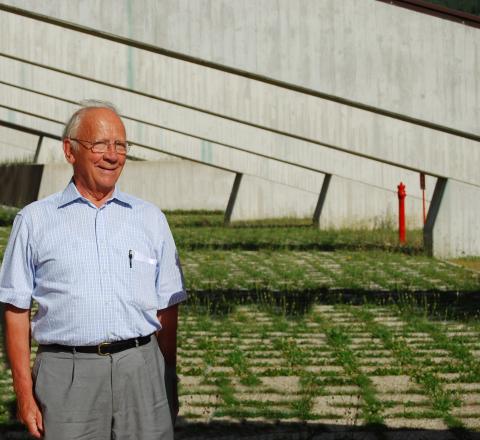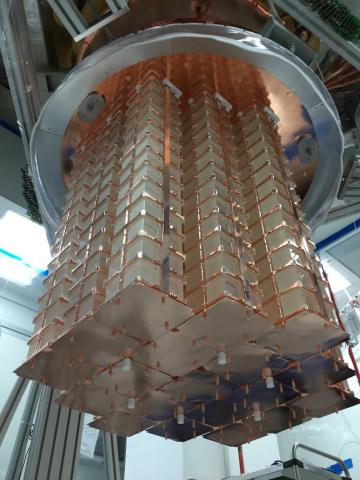News of the Passing of Ettore Fiorini
Submitted by kenneth_vetter on Tue, 04/18/2023 - 10:13Ettore Fiorini left us on April 9, 2023. He was born in Verona on April 19, 1933. Endowed with exquisite sympathy and politeness as well as great intelligence, Ettore is certainly a legend in the world of science. With him, we lose a father of Italian physics who raised many generations of scientists who carry on his legacy.
After graduating with Giovanni Polvani, he immediately began working in his group on making measurements in high mountains with Wilson chambers for the study of cosmic radiation. In the same years he manifested his love for the research of neutrinoless double beta decay, of which he can be considered one of the pioneers as well as the father of the Germanium diode technique. He conducted the first experiment in Turin, together with Antonino Pullia using the first prototypes of Germanium diodes developed in Ispra. In the following years he began his collaboration with the Lagarrigue group, where he learned the bubble chamber technique. It was from this collaboration that Gargamelle was born, the heavy-liquid bubble chamber with which he would be a major player in the discovery of weak neutral interactions in 1973. In the following years, while he continued his collaboration with his colleagues at CERN, his tireless spirit and insatiable curiosity pushed him to search for new techniques to experimentally verify whether fundamental properties of nature, now considered obvious, are true or not: lepton and baryon numbers, electric charge, and the stability of the constituents of electrons and nucleons. He thus proposed an experiment at Legnaro to search for parity violation in nuclei, and in the same years he headed an international collaboration to carry out an experiment to search for nucleon decay in the Mont Blanc tunnel. NUSEX, as the experiment was called, represented the first application of Iarocci's tubes and, despite its small size (a cube of about 3 meters on a side), produced results competitive with those of the leading experiments of the day: IMB and Kamiokande. Moreover, NUSEX was one of the first experiments conducted underground, when real laboratories of this kind did not yet exist in the western world. In 1979, however, a new underground laboratory dedicated to fundamental physics research was about to be born: in fact, Antonino Zichichi, then INFN president, presented the "Gran Sasso Project" to the Italian Senate, which was approved by Parliament with two funding laws in 1982 and 1984.
While NUSEX was taking data at garage 17 in the Mont Blanc tunnel, Ettore then spearheaded interest in the new Abruzzo laboratory: he began a campaign of site characterization measurements while the laboratory was still being excavated. At the same time he carried out a new campaign of measurements on the double beta decay of 76Ge at garage 27 of Mont Blanc employing two of the first commercially produced Germanium diodes. The experiment can certainly be considered the progenitor of a long family of experiments of increasing size and sensitivity that, passing through Heidelberg-Moscow, IGEX, MJD and GERDA, culminate today with the proposed LEGEND 1000.
In 1986, when the Gran Sasso Laboratories were not yet completed, he proposed to install a high-pressure gaseous Xenon detector (a multiproportional chamber) in one of the highway bypasses near the laboratories. He then entered with his group into one of the first major experiments proposed for the new laboratories, named GALLEX, for the measurement of solar neutrinos produced in proton-proton fusion reactions. The success of this experiment, with the first experimental demonstration of the mechanisms of energy production in the sun, gave a strong impetus to the Gran Sasso laboratories, which became the standard for underground experiments for the study of neutrinos and the search for rare events.
In the same year (1984), Ettore proposed to develop a new technique, that of very low temperature calorimeters, to be applied to studies such as double beta decay, the search for dark matter, and the direct measurement of the neutrino mass. At the time of the proposal, the masses of the detectors were a few fractions of a gram, and his friend Frank Avignone was not ashamed to call it a "crazy" idea. With his characteristic tenacity, Ettore decided that it was not only a viable technique, but also a promising one. Two separate lines of research were born, one for the development of large-mass bolometers for the study of double beta decay, the other for the realization of microbolometers for the determination of neutrino mass. After about 20 years of tireless work, in 1998 Ettore proposed together with Frank Avignone the construction of CUORE, an array of about 1,000 bolometers with a total mass on the order of a tonne. Its construction would begin only a decade later after the success of Cuoricino, a smaller version of the experiment.
CUORE has been taking data at Gran Sasso since 2017 and represents, as Ettore often said, the realization of one of his great dreams and also the conclusion of his scientific adventure in elementary particle physics. Even so, he never stopped supporting developments in the technique that led to the proposal of CUPID, the version of CUORE improved with the use of scintillating bolometers.
Blessed with a gracious disposition and innate friendliness, we always heard him say of each colleague that he was a great friend of them. Indeed Ettore was able to collaborate with scientists from all over the world and manage the first international collaborations of a certain size. He was also a man of great culture, always had a Latin quote or motto ready and delighted his interlocutors with anecdotes and stories.
His returns from vacations or missions around the world were overwhelming. Excited with boyish enthusiasm, he would tell his collaborators about new ideas or new proposals, drawing them into new adventures.
Professor emeritus at the University of Milan Bicocca, Ettore authored several hundred scientific papers. He was director of the Milan INFN Section and a professor beloved by his students at both the University of Milan and Milan Bicocca. He was among the founders of the INFN Section and the Physics Department of Milano Bicocca. A national member of the Accademia dei Lincei since 1988, he devoted himself fervently to promoting its initiatives. He was the recipient of important awards, such as the Feltrinelli Prize for the discovery of weak neutral currents, the Pontecorvo Prize for his studies on neutrino physics, and the Benemeriti medal of Culture and Science.
Ettore should also be remembered for some of his forays into other scientific fields, such as physics applied to the environment, medicine and cultural heritage. Among other things, he was co-director of the school of medical physics at the University of Milan for many years. In addition, from the accident at the Chernobyl nuclear power plant in 1986, through the minor accidents in Spain in '98 to the Fukushima accident in 2011, Ettore has always made available to society the knowledge and instrumentation used in particle physics to assess the impact that the release of radioactive contaminants has on human health and the environment.
In his later years he cultivated a passion for archaeometry, which began with the recovery of more than a thousand ancient lead ingots from the Roman era, found by a diver in the late 1980s off the island of Mal di Ventre in Sardinia. This was an exceptional find of an ancient Roman ship, sunk off the coast of Sardinia more than 2,000 years ago whose cargo, due to its low radioactivity content (210Pb) could be an exceptionally useful element in rare-event physics experiments. After reading the news in the newspapers, Ettore immediately took off on a spearhead, involving INFN and then-president Cabibbo, who immediately embraced the idea of funding the recovery of the ingots. From there began a whole series of activities, such as the study of the hair of Napoleon and his contemporaries to determine whether or not the emperor had been poisoned with arsenic, or such as the measurements of lead isotope ratios to establish the provenance of archaeological finds from the Nuragic Site of Sant'Imbenia (or the Lupa Capitolina). In each of these activities Ettore combined the enthusiasm of a child, with which he transmitted positive energy to all who collaborated with him, and the rigorousness of an experimental physicist typical of research in particle physics.
Ettore had an eye capable of going beyond immediate contingencies and could sense the scope of an experiment even at the level of its impact on the general public. His guidance, jokes, anecdotes, and proverbial insight as an experimental physicist will be missed. As he often liked to remind us: of the companions of our lives when they leave us we should not say "they are no more," but with gratitude "they have been with us" (Anton Chekhov).


